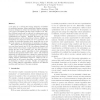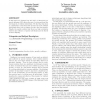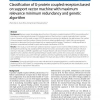799 search results - page 6 / 160 » Function Sequence Genetic Programming |
PRICAI
2004
Springer
14 years 1 months ago
2004
Springer
Abstract. A successful case of applying brute-force search to functional programming automation is presented and compared with a conventional genetic programming method. From the i...
LCTRTS
1999
Springer
13 years 12 months ago
1999
Springer
Code space is a critical issue facing designers of software for embedded systems. Many traditional compiler optimizations are designed to reduce the execution time of compiled cod...
GECCO
2005
Springer
14 years 1 months ago
2005
Springer
In this paper we examine how the choice of functions in a genetic program (GP) affects the rate of code growth and the development of resilient individuals. We find that functio...
CP
2003
Springer
14 years 26 days ago
2003
Springer
Multiple sequence alignment is a central problem in Bioinformatics. A known integer programming approach is to apply branch-and-cut to exponentially large graph-theoretic models. T...
BMCBI
2010
13 years 7 months ago
2010
Background: Because a priori knowledge about function of G protein-coupled receptors (GPCRs) can provide useful information to pharmaceutical research, the determination of their ...



